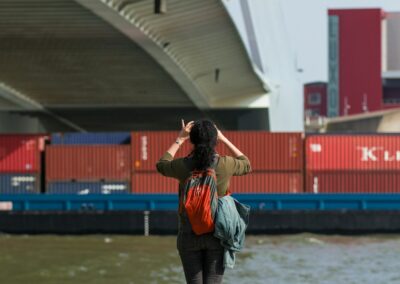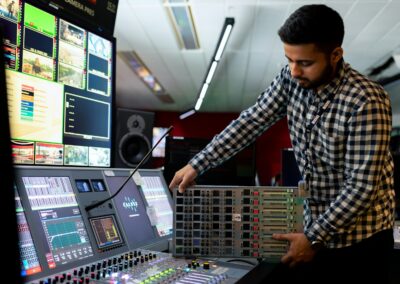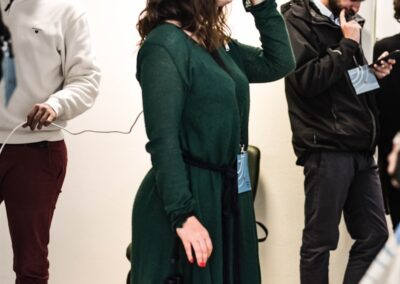The Future of Family Travel Through Augmented Reality
Transforming Travel Experiences for Young Travelers with AR
The integration of AR for children and young travelers is revolutionizing the way families explore new destinations. Augmented Reality (AR) technology offers interactive and engaging experiences that capture the imagination of younger audiences, making travel more educational and entertaining. For instance, the Dubai Aquarium & Underwater Zoo uses AR to create interactive marine life experiences. Children can point their devices at specific exhibits to see virtual sea creatures come to life, complete with detailed information and fun facts. This not only entertains but also educates young visitors, enriching their overall experience.
In Riyadh, the King Abdulaziz Historical Center has implemented AR to make history more accessible and interesting for children. Through AR applications, young visitors can witness historical reenactments and interact with digital artifacts. This immersive approach transforms a traditional museum visit into an exciting adventure, fostering a deeper interest in history and culture. The use of AR in such educational settings helps children retain information better and stimulates their curiosity about the world around them.
The UAE’s LEGOLAND Dubai theme park has also adopted AR to enhance its attractions. By using AR apps, children can engage in virtual treasure hunts, solve puzzles, and interact with their favorite LEGO characters in real time. These interactive experiences are designed to keep children entertained while also promoting problem-solving skills and creativity. The seamless integration of AR in theme parks provides a dynamic and engaging environment for young travelers, ensuring that their visits are both fun and educational.
Key Features of Effective AR Content for Children
The effectiveness of AR for children and young travelers lies in its ability to combine entertainment with education. One critical feature is the use of interactive elements that encourage active participation. AR applications that incorporate games, quizzes, and challenges keep children engaged and make learning fun. For example, the AR app at the Dubai Aquarium includes interactive quizzes about marine life, rewarding children with virtual badges for correct answers. This gamified approach motivates children to learn more while enjoying their visit.
Another essential feature is the use of vivid and appealing visual content. Children are naturally drawn to bright colors and animations, making AR an ideal medium for capturing their attention. Applications that use high-quality graphics and animations can create captivating experiences that hold children’s interest. The AR app at LEGOLAND Dubai, for instance, uses vibrant animations and sound effects to bring LEGO characters to life, creating an immersive experience that children find irresistible.
Personalization is also a key factor in the success of AR applications for young travelers. Apps that offer personalized experiences based on the child’s interests and preferences can significantly enhance engagement. For instance, an AR app at the King Abdulaziz Historical Center might allow children to choose which historical period or character they want to learn about, tailoring the experience to their individual interests. Personalization ensures that the content is relevant and engaging, making the learning experience more impactful.
Challenges and Solutions in Developing AR Content for Young Travelers
Developing effective AR for children and young travelers comes with several challenges. One major challenge is ensuring that the content is both engaging and educational. It is essential to strike a balance between fun and learning to keep children interested while also providing valuable information. Developers must work closely with educators and child psychologists to design content that meets educational standards while remaining entertaining.
Another challenge is ensuring the safety and privacy of young users. AR applications often require access to the device’s camera and location data, raising concerns about data security. Developers must implement robust security measures to protect user data and ensure that the applications comply with privacy regulations. Parental controls and permissions can also be incorporated to give parents peace of mind while their children use the apps.
Accessibility is another important consideration. AR applications should be designed to be user-friendly and accessible to children of all ages and abilities. This includes intuitive interfaces, simple navigation, and clear instructions. Developers should also consider the physical and cognitive abilities of young users, ensuring that the content is appropriate and easy to use. In tech-forward regions like Saudi Arabia and the UAE, where technology adoption is high, creating inclusive and accessible AR applications is crucial for widespread acceptance and use.
Conclusion: The Future of AR in Enhancing Family Travel
In conclusion, the integration of AR for children and young travelers presents a significant opportunity to enhance family travel experiences. By addressing challenges related to content balance, data security, and accessibility, AR applications can provide immersive, engaging, and educational experiences for young travelers. In regions like Saudi Arabia and the UAE, where tourism and technology are rapidly advancing, leveraging AR to create memorable travel experiences for families will be key to achieving success in the competitive tourism industry.
—
#ARForChildren #AugmentedRealityTourism #InteractiveTravelContent #ARInTourism #EngagingTravelExperiences #SaudiArabiaTourism #UAETourism #Riyadh #Dubai #ModernTechnology #BusinessSuccess #Leadership #ProjectManagement























